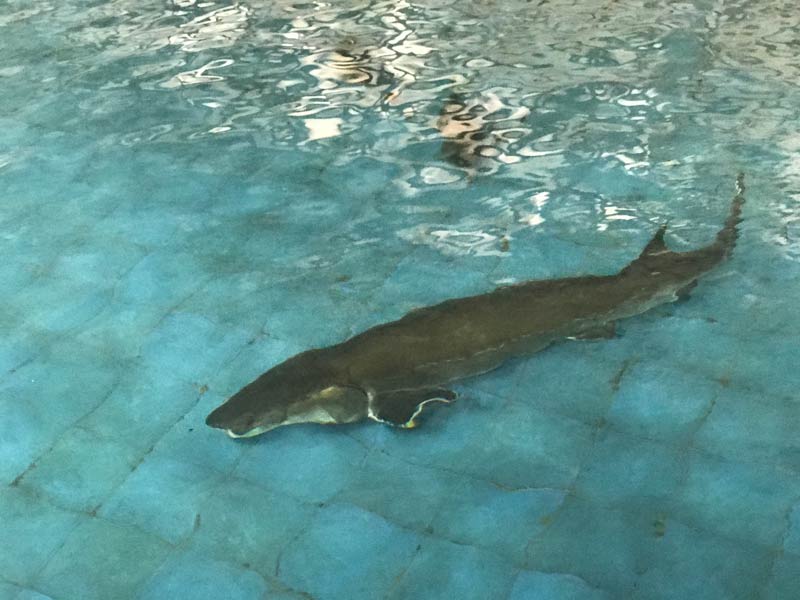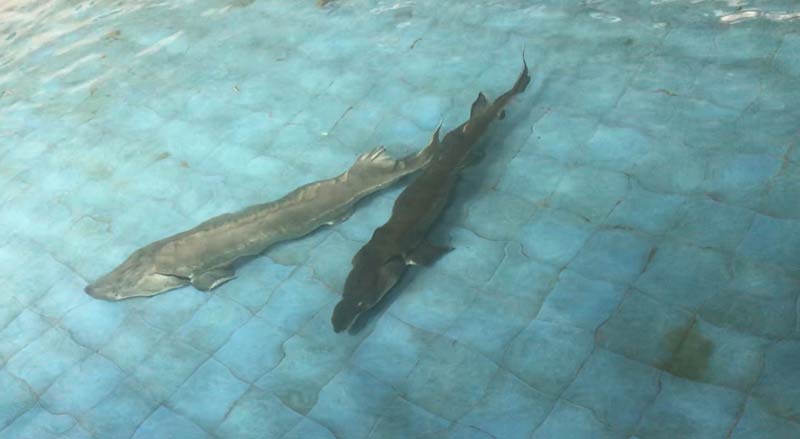Through artificial breeding and release, Chinese scientists have helped the population of Chinese sturgeons grow over the years, which protects both the endangered species and the biodiversity of the Yangtze River.
Known as a living fossil, the Chinese sturgeon, which has existed on earth for over 140 million years, is as old as the dinosaurs. An adult fish can grow up to 5 meters long and weigh 500 kilograms (over 1,100 pounds), with a life span of about 100 years.

(Photos: Yang Yang/People's Daily Online)
Although it spends most of its time in the sea, the Chinese sturgeon is actually a freshwater fish. When reaching sexual maturity, the fish will head to shallow water, entering the Yangtze River estuary from summer to autumn.
It then swims against the current to lay eggs in autumn. An adult fish can lay 300,000 to 1.3 million eggs at one time. After that, it migrates back to the sea. The fertilized eggs will hatch and then the babies swim to the sea next spring.
Although the Chinese sturgeon’s reproductive capacity is excellent, it faces the threat of extinction due to over hunting, river pollution, shipping interference, and excessive sand excavation in the river basin. The fish has been listed as critically endangered by the International Union for the Conservation of Nature (IUCN). In 1988, the Chinese government added Chinese sturgeon to its list of Class I protected species, banning people from hunting them.
As early as 1982, the Chinese government set up the Chinese Sturgeon Research Center, the first of its kind, to protect the precious and rare fish, and to research the reproduction of the species in captivity.
“Since 1984, for 60 times, we have released more than five million Chinese sturgeon of various sizes into the river,” said Li Zhiyuan, vice-director of the Chinese Sturgeon Research Center in Yichang, Hubei province.
Monitoring data shows that the survival rate of the Chinese sturgeon released from Yichang in recent years has reached more than 50 percent. Now, the Chinese sturgeon is used to measure the health of the ecosystem along the Yangtze River.
At the research center, wild Chinese sturgeons and the first and second generations of artificially bred ones are all swimming freely inside water tanks. Although most of them are born and raised in a controlled environment, studies show that there genetics and habits are identical.

Nevertheless, Chinese sturgeons suffer a severe gender imbalance, with the male and female ratio being 1:7.
In response, the institute introduced a breakthrough the research center had made in 2013—female parthenogenesis, or getting fish fry simply by inducing eggs to hatch through modern biotechnology methods. “Mother sturgeons can give birth to baby sturgeons alone,” Li said.
“Artificial technology is only an auxiliary means,” Li emphasized. “The protection and improvement of the ecosystem of the whole river basin is most important, and that requires the joint efforts of society.”


